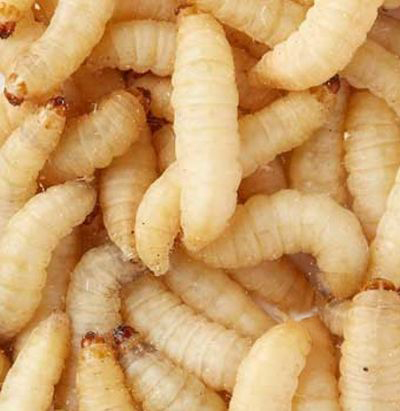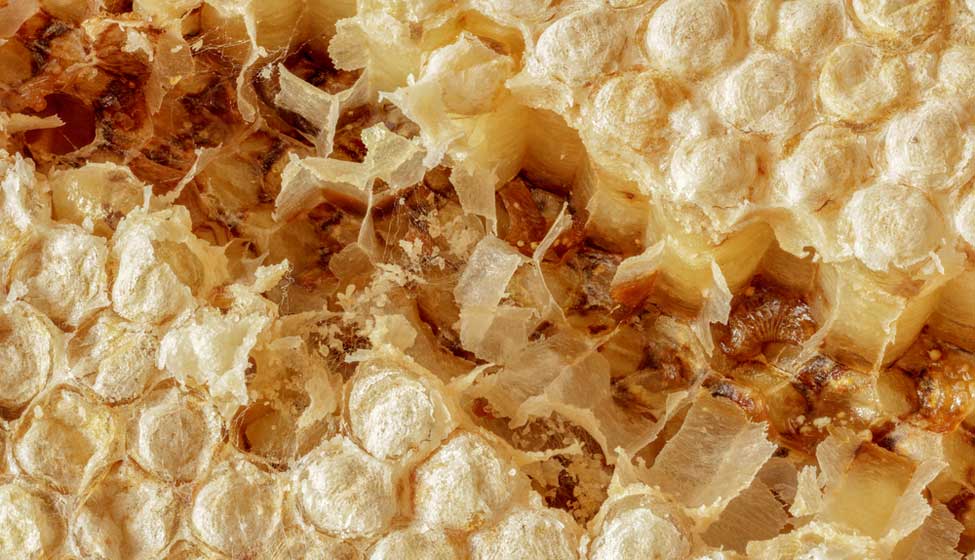A chance discovery of a worm that chucks down polythene could be the answer to millions of polythene bags accumulated as waste on land and water.
European beekeepers are familiar with wax worms that prey inside beehives and thrive on eating honey and beeswax. While the greater wax moth caterpillar or the larva of the moth Galleria mellonella is a menace to the beehives in Europe it is used as a fishing bait in America.
Frederica Bertocchini, a biologist at the Institute of Biomedicine and Biotechnology of Cantabria in Spain, found that wax worm had infested her beehive. She removed worms from the honeycomb panels, carefully put them in a polythene bag and tied it to prevent the caterpillars from escaping. After a while, she was dismayed to find that they were running loose and the polythene bags were ridden with holes. The worms had escaped after chewing down holes on the polythene bag. She noted that the worm not just chewed a hole through the plastic but had actually eaten the stuff.
Thrilled by the accidental discovery, Dr Bertocchni joined a team of researchers at University of Cambridge's biochemistry department and undertook a study on how the worm consumed the polythene. The team put a hundred worms in a UK supermarket polythene carry bag. They found new holes were cut in the bag in just 40 minutes. After 12 hours, the worms had eaten away 92 milligrams of plastic mass from the bag.
Spectroscopic studies confirmed that not only were the caterpillars chewing, but chemical bonds in the plastic had broken down. “Wax is a polymer, a sort of ‘natural plastic,’ and has a chemical structure not dissimilar to polyethylene,” explains Dr Bertocchini. The worms have broken down the polymer chains in the plastic, transforming the polyethylene into ethylene glycol, which is used for manufacturing plastics.
The caterpillar produces a secretion that chemically breaks down chemical bonds in the plastic. However, the scientists are still unsure whether the enzyme is produced by the worms or by some bacteria which live inside these worms.
Researchers are aiming to identify the enzymes in the wax worms’ digestive system that dissolves plastic. If they are successful in isolating this enzyme that causes the breakdown of the polymer structure in plastic, it would be possible to implant that particular gene into the genes of the bacteria. The biotechnology method will be easier than using an army of worms to attack plastic waste.
Scientists have been trying to find a permanent solution to the plastic garbage.
Some microbes are capable of degrading plastics but they are much slower than the wax worms. The fungus Penicillium simplicissimum can degrade plastics in about three months. The bacterium Nocardia asteroides are faster, but takes a couple of weeks. But none of these organisms produce ethylene glycol like wax worms.
Though some progress has been made in the recent years using meal worms and some bacteria, Bertocchini’s worm works incredibly faster than all other organisms which researchers had tried.
Eco-destructive?
 Wax worms produce a secretion that chemically breaks down chemical bonds in the plastic
Wax worms produce a secretion that chemically breaks down chemical bonds in the plastic
Plastic waste is a huge problem created by modern lifestyle. America alone uses about 102 billion plastic carry bags a year. Globally, nearly one trillion polythene bags are consumed every year. And about 38 per cent of them end up as landfills that need a millennium to decompose.
Polythene is found to be one of the worst kind of plastics to break down. Since it is highly resistant to degradation, it can harm our eco system. Wax worms can break down the carbon structure in the polythene helping it to decompose in a natural way. After repeated successes with the worms, the researchers have filed for a patent on their breakthrough in resolving the plastic garbage crisis. The study got published in Current Biology.
However, a few scientists have expressed reservation about using wax worms to rot out plastic waste on a large scale. Ramani Narayan who studies degradation of plastic at Michigan University told The Atlantic that using worms to chew down plastic waste could give rise to new environmental issues. The disintegrated plastic stuff produces small bits that “pick up toxins like sponge, transport these toxins up the food chain, and can cause harm to the environment and human health,” said Narayan.




